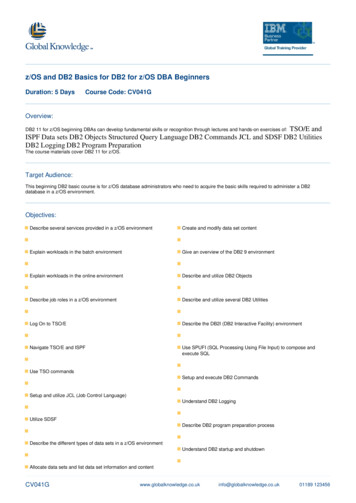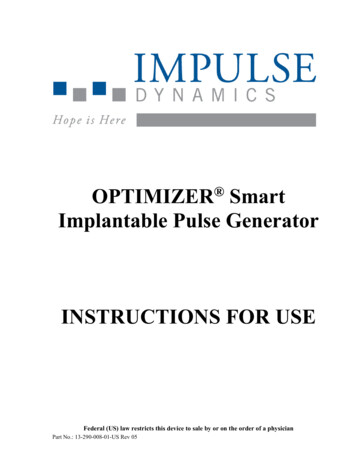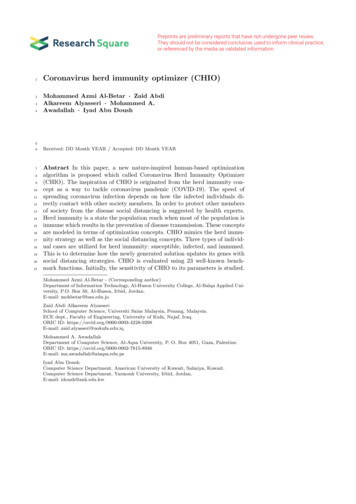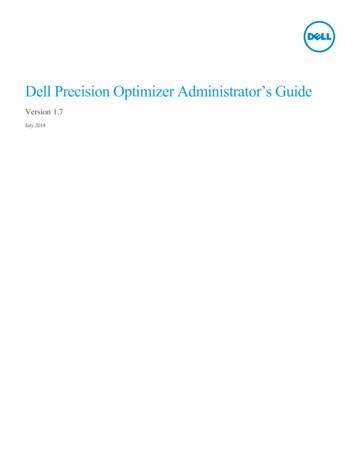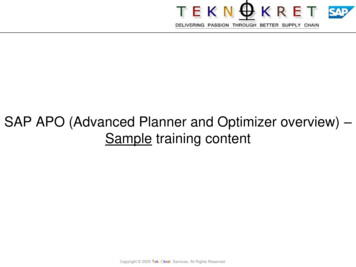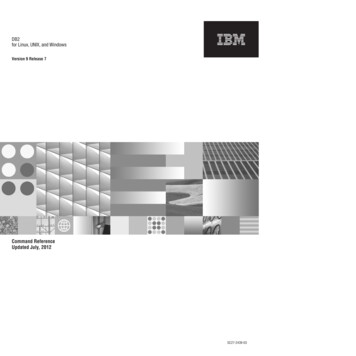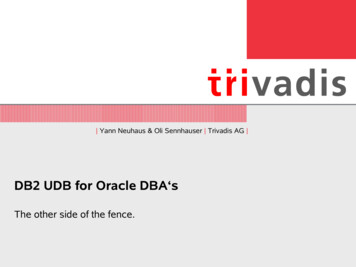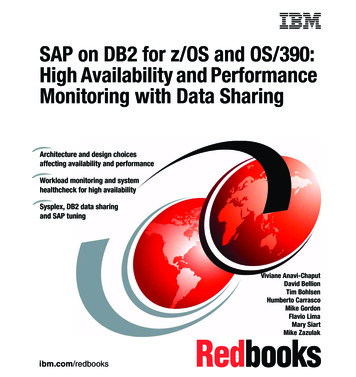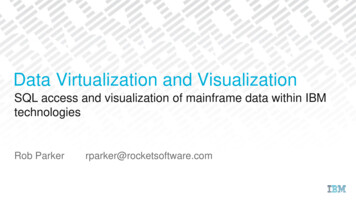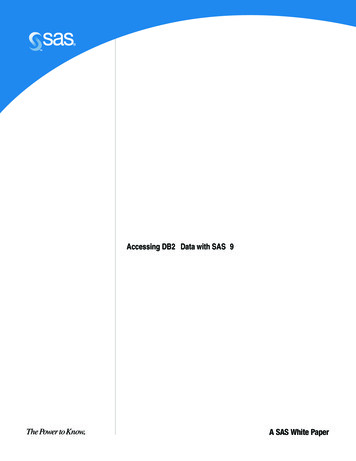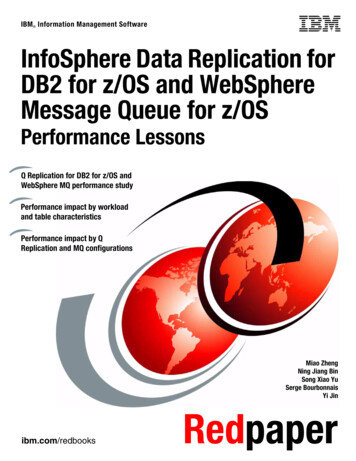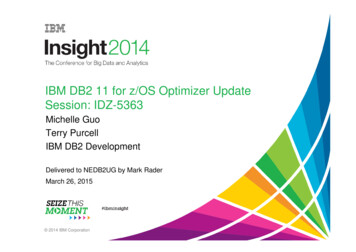
Transcription
IBM DB2 11 for z/OS Optimizer UpdateSession: IDZ-5363Michelle GuoTerry PurcellIBM DB2 DevelopmentDelivered to NEDB2UG by Mark RaderMarch 26, 2015 2014 IBM Corporation
AgendaPlan ManagementPredicate IndexabilityIn-Memory Data Cache (sparse index)Duplicate RemovalDPSIs and page rangeMisc Performance enhancementsOptimizer externalization and input enhancements2
Plan ManagementEnhancements
Static Plan Management –APREUSE(WARN) DB2 10 delivered APREUSE(ERROR)Allowed potential for reuse of prior plan to generate new runtime structureFailure of reuse failed the entire packageAPREUSE(ERROR) EXPLAIN(ONLY) failure may not represent a valid plan in DB2 10 Failed access path is written to PLAN TABLE DB2 11 delivers APREUSE(WARN)Upon failure of reuse, Optimizer will generate a new access path choice Thus failure of 1 SQL will not fail the entire packagePLAN TABLE output will represent a valid plan For both ERROR or WARN4
APREUSE Comparison of ERROR and WARN APREUSE(ERROR)Effectively operates at the package level APREUSE(WARN)Effectively operates at the statement level ExampleREBIND on a workload in which 3% of the queries fail their respectivehints With APREUSE(WARN)– Access paths kept on all statements that took the hint– Fresh access paths for statements on which the hint failed– All packages rebound successfully and 97% of SQLs succeed With APREUSE(ERROR)– Access paths kept for all packages that took all hints– Package REBIND failure where a hint failed– Worst case 100% of packages fail (if each has 30 SQL and 1 fails)5
Predicate IndexabilityImprovements
Rewrite Common Stage 2 predicates to indexable Targeted Stage 2 predicatesYEAR(DATE COL)DATE(TIMESTAMP COL)value BETWEEN C1 AND C2SUBSTR(C1,1,10)SUBSTR from position 1 only Stage 2 predicates ONLY rewritten if no candidate Index OnExpression to support the predicateRegardless of whether the optimizer chooses that IOE Applies to literals or host variables/parameter markersRequires REBIND for static NOTE: Increase in matchcols will cause APREUSE(ERROR) to failAPREUSE(WARN) will succeed if only change is matchcol increase7
Stage 2 predicate rewrite examples EQUAL Example:WHERE YEAR(DATE COL) 2012stage 2BecomesWHERE DATE COL BETWEEN ‘2012-01-01’ AND ‘2012-12-31’indexable Also applies to IN, BETWEEN, range predicates etc Range Example:WHERE SUBSTR(CITY,1,3) :hvstage 2BecomesWHERE CITY (exp)(exp is a DB2 computed value for boundaries of column)Indexable For example: SUBSTR(CITY,1,3) ‘ABC’– Becomes CITY x’C1C2C3FFFFFFFFFFFFFF’8
Value BETWEEN two columns Example:SELECT *FROM TABLEWHERE :hv BETWEEN START DATE AND END DATEStage 2BecomesSELECT *FROM TABLEWHERE START DATE :hvAND END DATE :hvindexableindexableNOTE: COL BETWEEN :hv1 AND :hv2 is already indexable9
Indexability for OR/IN and OR COL IS NULL Improved single matching index access for OR C1 IS NULLExamplesWHERE C1 ? OR C1 IS NULLWHERE C1 IN (1, 2) OR C1 IS NULLWHERE C1 ? OR C1 IS NULL IN/OR combination to allow multi-index access WHERE C1 ? OR C2 IN (1,2)BecomesWHERE C1 ? OR C2 1 OR C2 210
Prune always true predicates Example WHERE 1 1So what’s the problem with this harmless predicate? DB2 will execute the WHERE 1 1 predicate for every qualified row SELECT *FROM TABLEWHERE 1 1AND CUSTNO ?Prune always true predicate to become SELECT *FROM TABLEWHERE CUSTNO ?11
Prune always false predicates DB2 10 already prunes “always false” equal/IN under ORWHERE C1 ? OR ‘A’ ‘B’ DB2 11 extends to “always false” underneath parent “AND” SELECT *FROM TABLE1 T1, TABLE2 T2WHERE (1 1 AND T1.C1 T2.C1)OR (1 2 AND T1.C2 T2.C2)Prune always true/false predicates to become SELECT *FROM TABLE1 T1, TABLE2 T2WHERE T1.C1 T2.C1 NOTE: “OR 0 1” is NOT pruned NOTE2: Literals only. No host vars/markers. No reopt.12
Indexability for CASE predicates Case can now be indexable (formerly stage 2)For local predicate– SELECT *FROM T1WHERE COL CASEWHENWHENELSE(CAST(? AS INT))1 THEN 'CA'2 THEN 'NY''AL' END;For JOIN predicate CASE expression must be evaluated before the join. In example below, join predicate is indexable if T1 accessed before T2.– SELECT * FROM T1, T2WHERE T2.COL CASE WHEN T1.COL ‘Y’THEN T1.COL2ELSE T1.COL3END;13
Predicate Pushdown DB2 11 pushdown into materialized views/Table Expressions ofNon-boolean term (OR) predicateSELECT EMPNO, SALARY, DEPTCOUNTFROMEMP A ,(SELECT WORKDEPT, COUNT(*)FROMEMPGROUP BY WORKDEPT) AS B(WORKDEPT, DEPTCOUNT)WHERE A.WORKDEPT B.WORKDEPTAND (B.WORKDEPT LIKE 'C%' OR B.WORKDEPT LIKE 'A%‘); Stage 2 predicates (expressions)SELECT EMPNO, SALARY, DEPTCOUNTFROMEMP A ,(SELECT WORKDEPT, COUNT(*)FROMEMPGROUP BY WORKDEPT) AS B(WORKDEPT, DEPTCOUNT)WHERE A.WORKDEPT B.WORKDEPTAND UPPER( B.WORKDEPT) 'C01'14
Predicate Pushdowns (cont.)Predicate in the ON clause of an outer joinSELECT EMPNO, SALARY, DEPTCOUNTFROMEMP ALEFT OUTER JOIN(SELECT WORKDEPT, COUNT(*)FROMEMPGROUP BY WORKDEPT) AS B(WORKDEPT, DEPTCOUNT)ON A.WORKDEPT B.WORKDEPTAND B.WORKDEPT 'C01';Also when the view/Table Expression contains a scalar function in theSELECT listSome restrictions still remain, such as: If all 3 examples had predicates against table A – predicate not pushed in Expression pushdown may not qualify for index on expression15
In-memory data cache /sparse index
In Memory Data Cache & Sparse Index History V4: Sparse Index for non-correlated subquery workfiles V7: Sparse Index for materialized workfiles for star join V8: IMDC enhancement for star join Fallback to sparse index when insufficient memory V9: IMDC / SI extended to non-star join when table lack index on joincolumns (Generalized Sparse Index) Also supports multicolumn sparse index MXDTCACH ZParm Maximum memory for data caching per thread 0-512MB (default 20MB) 0 Only Sparse Index (key rid) applied V10: Add hash support for sparse index (as alternative to binary search) When result would be contained in MXDTCACH17
In Memory Data Cache vs. Sparse Index IMDC (hash or binary search) Sparse Index When insufficient memory for IMDCT1NLJT2 (WF)T1NLJT2 (WF)Workfile sortedin t2.c ordert1.c t2.ct1.c t2.cIMDC sorted in t2.corderT2(WF)Binary Search of WF to look up exactlocation of qualified key (Hash used ifsufficient memory)Key RID. .T2(WF)Sparse Index sortedin t2.c orderBinary Search of sparse index to look up“approximate “ location of qualified key18
IMDC/Sparse Index DB2 11 Enhancements Improved memory management by optimizer and runtime Controlled by zparm MXDTCACH (default 20MB) Each sparse index/IMDC is given a % of MXDTCACH From optimizer cost perspective At runtime (based upon cost estimation) Runtime will choose appropriate implementation based upon available storage Hash, binary search, or spill over to workfile Improved optimizer cost model Allowing this to be opened up in more join scenarios Improvements to IFCID 27 for detail, 2 & 3 for summary19
IMDC/Sparse index – Tuning basics DB2 11 provides simple accounting/statistics data for sparse indexSparse IX disabled indicates main memory was insufficient for the MXDTCACH memoryrequest Suggest reducing MXDTCACH or allocating more memory to the systemSparse IX built WF MXDTCACH was insufficient to contain sparse index– Increase MXDTCACH Look at sort BP sync I/O– If high, also reduce VPSEQT in sort BP (do not use VPSEQT 100)MISCELLANEOUS-------------------SPARSE IX DISABLEDSPARSE IX BUILT WFAVERAGE-------0.000.36TOTAL-------0820
Duplicate Removal
Index skipping and Early-out – DB2 11 Enhancements Improvements to queries involving GROUP BY, DISTINCT or non-correlated subq Where an index can be used for sort avoidance By skipping over duplicates (see next few slides) Improvement to join queries using GROUP BY, DISTINCT By NOT accessing duplicates from inner table of a join if DISTINCT/GROUP BY will remove thoseduplicates Improvement to correlated subqueries Early-out for ordered access to MAX/MIN correlated subqueries When I1-fetch is not available Optimize usage of the “result cache” for access to subquery with duplicate keys fromthe outer query 100 element result cache dates back to DB2 V2 as a runtime optimization DB2 11 adds optimizer recognition of benefit22
Pre-DB2 11 Duplicate Removal using an index (no sort)SELECT C1FROM TGROUP BY D.RIDScan qualified leaf pages (and all rids) with runtime discarding duplicates23
DB2 11 - Duplicate Removal with Index SkippingSELECT C1FROM TGROUP BY D.RIDIndex Skipping (over-simplified)Use index lookaside (current leaf high key and non-leaf) to getthe next key greater than current key24
Early-out join DB2 11 supports early-out for joins if duplicates not necessaryPreviously only avail for correlated EXISTS subquery transformed to join.For below example: Duplicates from T2 are removed by DISTINCT In DB2 11, each inner table probe will stop after 1st match is found– NOTE: For LEFT OUTER JOIN V10 will prune T2SELECT DISTINCT T1.*FROM T1, T2WHERE T1.C1 T2.C1 Also apply to Non-Boolean Term join conditions with “early-out” tableSELECT DISTINCT T1.*FROM T1, T2WHERE T1.C1 1OR T1.C1 T2.C125
Optimize usage of subquery result cache DB2 V2 introduced a result cache for saving the 100 most recent correlatedsubquery execution resultsEach subquery execution would 1st scan the cache to find the result If found, cache value is used If not found, subquery is executed, and result saved in cache DB2 11 adds optimizer recognition of the cacheOrdered access will reduce the cache size from 100 Example below, accessing the outer in CUSTNO order (via CUSTNO index ortablespace scan if CUSTNO clustering) would result in cache hits for repeatCUSTNO valuesSELECT *FROM POLICY P1WHERE P1.POLICY DATE (SELECT MAX(P2.POLICY DATE)FROM POLICY P2WHERE P2.CUSTNO P1.CUSTNO)26
DPSI and Page Range
Page Range Screening – DB2 11Enhancements Page range performance ImprovementsPage Range Screening on Join Predicates Access only qualified partitionsPre-DB2 11, page range screening only applied to local predicates With literals, host variables or parameter markersApplies to index access or tablespace scan Benefits NPIs by reducing data access only to qualified parts Biggest benefit to DPSIs by reducing access only to qualified DPSIparts Only for equal predicates, same datatype/length only28
Pre-V11 Page Range Join Probing (Join on partitioning Col) Current challengeComposite rowprobes all partsYEARPARTNO2009201020112012201312345SELECT *FROM T1, T2WHERE T1.PARTNO T2.PARTNOAND T1.YEAR 2011AND T2.ACCTNO 12345T2Partition by PARTNODPSI on ACCTNO1234295
V11 Page Range Join Probing (Join on Partitioning Col) Join recognizes pagerange screeningOnly 1 partition LECT *FROM T1, T2WHERE T1.PARTNO T2.PARTNOAND T1.YEAR 2011AND T2.ACCTNO 12345T2Partition by PARTNODPSI on ACCTNO1233045
DPSI – DB2 11 Enhancements DPSI can benefit from page range screening from joinAssuming you partition by columns used in joins (see previous slides) For DPSIs on join columns and partition by other columnsDB2 11 Improves DPSI Join Performance (using parallelism) Controlled by ZPARM PARAMDEG DPSI Sort avoidance for DPSIs (also known as DPSI merge)Use of Index On Expression (IOE) Ability to avoid sorting with DPSI IOE (already available for DPSI non-IOE)Index lookaside when DPSI used for sort avoidance Straw-model parallelism support for DPSIStraw-model (delivered in V10) implies that DB2 creates more work elements than there aredegrees on parallelism.31
Pre-V11 DPSI Probing Challenge for Joins NOTE: No page range join predicate Current challenge for join to a DPSI1st composite row probes all parts2nd composite row probes all partsEtcSELECT *FROM T1, T2WHERE T1.C1 T2.C1C1123T2DPSI on C1Partition by YEAR2010 2011 2012 2013 201432
DPSI Probing – DB2 11 Join Solution DPSI part-level Nested Loop JoinShare composite table for each child task (diagram shows a copy) Each child task is a 2 table join Allows each join to T2 to access index sequentially (and data if high CR)SELECT *T2FROM T1, T2DPSI on C1WHERE T1.C1 14
DPSI – what is the message? A “partitioned” index means excellent utility performanceBut historically there was one sweet spot ONLY for DPSIs When local predicates in the query could limit partitions to be accessed Does DB2 11 allow me to switch all NPIs to DPSIs?NO, but the sweet spot just got a little bigger NPIs still are necessary in many workloadsTPCH 30 V11 NPI vs. V11 DPSI How do NPIs & DPSIs now compare?Internal TPCH measurement250.0%200.0%150.0% DPSIs increased CPU on avg by 8%– But 1 query was 200% !!!!100.0%CPU delta50.0%0.0%DB2 11 ESP customer feedbackQ5Q7Q9Q11Q14Q17Q19Q20Q21Q22-50.0% 2 customers reported 75% CPU improvement for DPSIs (no other details provided)34
Misc Performance Items
CPU speed impact on access paths DB2 11 can reduce access path changes based upon different CPUsAcross data sharing membersAfter CPU upgradeDevelopment vs production with different CPU speedsApplies to z10 to z196 or zEC12, or z196 to zEC12– And later CPUs36
Sort / Workfile Performance In memory workfile support in DB2 9 and 10Final sort in DB2 9 (up to 32K) and 10 (up to 1MB)DB2 10 intermediate workfile usage up to 32K for selective path More in memory operation in DB2 11Final sort up to 128MB by zparm control MAXSORT IN MEMORY(default 1MB)Wider range of usage for in memory Materialized view, table expression, outer Join, EXISTS, etc.Avoid workfile usages for final merge on top level sortReduces physical workfile usage for large top level sort N
Prune always false predicates DB2 10 already prunes “always false” equal/IN under OR WHERE C1 ? OR ‘A’ ‘B’ DB2 11 extends to “always false” underneath parent “AND” SELECT * FROM TABLE1 T1, TABLE2 T2 WHERE ( 1 1 AND T1.C1 T2.C1) OR (1 2 AND T1.C2 T2.C2) Prune always true/false predicates to become SELECT * FROM TABLE1 T1, TABLE2 T2 WHERE T1.C1 T2.C1 .
